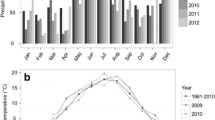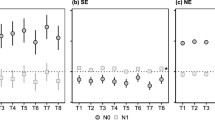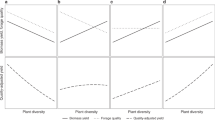Abstract
Short rotation coppice (SRC) plantations are predominantly established as monocultures. Reasons include simplicity and thus efficiency in planting, homogeneous growth, and a desire to maximize yields by selecting top-performing species. However, pests and disease outbreaks generally cause much greater damage to monocultures than to mixed plantations, thus affecting yields as well as other ecosystem services. Mixed SRC with varying genotypes or even species have the potential to positively affect biodiversity and ecosystem services, however, little is known about the quantity and quality of woody biomass from mixed SRC in respect to its use for energy generation. Therefore, we tested how volume, calorific value, and ash content of woody biomass are influenced by (1) diversity in genotypes in a Salix SRC, and (2) diversity of species in a Salix, Robinia, Paulownia, and Populus SRC. Results show that increasing the number of genotypes or species in a SRC plantation does not negatively affect woody biomass, calorific value, or ash content of wood chips. On average, the plots with mixed genotypes or tree species produced more biomass compared with monocultures of the component species. We found evidence of overyielding in mixtures of poplar and robinia. Our findings are relevant for managers planning new SRC plantations and indicated that mixtures of specific tree species or genotypes should be considered. Therefore, we argue that “high-diversity SRC” plantations represent a valuable alternative to conventional SRC for sustainable bioenergy production.




Similar content being viewed by others
References
European Commission. (2014) A policy framework for climate and energy in the period from 2020 up to 2030. Communication from the Commission to the European parliament, the council, the European economic and social committee and the committee of the regions Brussels: European Commission. http://eur-lex.europa.eu/legal-content/EN/TXT/PDF/?uri=CELEX:52014DC0015&from=EN (accessed July 27, 2018)
Klass DL (1998) Biomass for renewable energy, fuels, and chemicals. Academic Press, San Diego
Lettens S, Muys B, Ceulemans R, Moons E, Garcia J, Coppin P (2003) Energy budget and greenhouse gas balance evaluation of sustainable coppice systems for electricity production. Biomass Bioenergy 24:179–197
Werner C, Haas E, Grote R, Gauder M, Graeff-Hönninger S, Claupein W, Butterbach-Bahl K (2012) Biomass production potential from Populus short rotation systems in Romania. Global Change Biol Bioenergy 4:642–653
World Energy Council (2016) World energy resources bioenergy 2016. World Energy Council, London
Hoogwijk M, Faaij A, van den Broek R, Berndes G, Gielen D, Turkenburg W (2003) Exploration of the ranges of the global potential of biomass for energy. Biomass Bioenergy 25:119–133
Hoffmann D, Weih W (2005) Limitations and improvement of the potential utilization of woody biomass for energy derived from short rotation woody crops in Sweden and Germany. Biomass Bioenergy 18:267–279
Liberloo M, Calfapietra C, Lukac M, Godbold D, Luo ZB, Polle A et al (2006) Woody biomass production during the second rotation of a bio-energy Populus plantation increases in a future high CO2 world. Global Chance Biol Bioenergy 12:1094–1106
Djomo SN, El Kasmioui O, Ceulemans R (2010) Energy and greenhouse gas balance of bioenergy production from poplar and willow: a review. Global Change Biol Bioenergy 3:181–197
Peacock L, Herrick S, Brain P (2001a) Spatio-temporal dynamics of willow beetle (Phratora vulgatissima) in short-rotation coppice willows grown monocultures a genetically diverse mixture. Agric For Entomol 1(4):287–296
McCracken AR, Dawson WM (2003) Rust disease (Melampsora epited) of willow (Salix spp.) grown as short rotation coppice (SRC) in inter- and intra-species mixtures. Ann Appl Biol 143:381–393
Georgi R, Müller M (2015) Biotic risk factors in short rotation coppice in Germany: current situation, new findings and future perspectives. In: Butler Manning D, Bemmann A, Bredemeier M, Lamersdorf N, Ammer C (eds) Bioenergy from dendromass for the sustainable development of rural areas. Wiley-VCH Verlag GmbH & Co. KGaA, Weinheim, pp 199–216
Peacock L, Hunter T, Turner H, Brain P (2001b) Does host genotype diversity affect the distribution of insect and disease damage in willow cropping systems. J Appl Ecol 38:1070–1081
Verheyen K, Vanhellemont M, Auge H, Baeten L, Baraloto C, Barsoum N, Bilodeau-Gauthier S, Bruelheide H, Castagneyrol B, Godbold D, Haase J, Hector A, Jactel H, Koricheva J, Loreau M, Mereu S, Messier C, Muys B, Nolet P, Paquette A, Parker J, Perring M, Ponette Q, Potvin C, Reich P, Smith A, Weih M, Scherer-Lorenzen M (2016) Contributions of a global network of tree diversity experiments to sustainable forest plantations. Ambio. 45:29–41
Paquette A, Hector A, Castagneyrol B, Vanhellemont M, Koricheva J, Scherer-Lorenzen M et al (2018) A million and more trees for science. Nature Ecol Evol 2(5):763–766
McCracken AR, Walsh L, Moore PJ, Lynch M, Cowan P, Dawson M, Watson S (2011) Yield of willow (Salix spp.) grown in short rotation coppice mixtures in a long-term trial. Ann Appl Biol 159:229–243
Hoeber S, Arranz C, Nordh NE, Baum C, Low M, Nock C, Scherer-Lorenzen M, Weih M (2018) Genotype identity has a more important influence than genotype diversity on shoot biomass productivity in willow short-rotation coppices. Global Chance Biol Bioenergy 10:534–547
Hooper DU, Chapin FS, Ewel JJ, Hector A, Inchausti P, Lavorel S et al (2005) Effects of biodiversity on ecosystem functioning: a consensus of current knowledge. Ecol Monogr 75(1):3–35
Cardinale BJ, Matulich KL, Hooper DU, Byrnes JE, Duffy E, Gamfeldt L, Balvanera P, O'Connor MI, Gonzalez A (2011) The functional role of producer diversity in ecosystems. Am J Bot 98:572–592
Tilman D, Isbell F, Cowles JM (2014) Biodiversity and ecosystem functioning. Annu Rev Ecol Evol Syst 45:471–493
Duffy JE, Godwin CM, Cardinale BJ (2017) Biodiversity effects in the wild are common and as strong as key drivers of productivity. Nature. 549:261–264
Tilman D, Lehman CL, Thomson KT (1997) Plant diversity and ecosystem productivity: theoretical considerations. Proc Natl Acad Sci U S A 94:1857–1861
Loreau M, Hector A (2001) Partitioning selection and complementarity in biodiversity experiments. Nature. 412:72–76
Tullus A, Tullus H, Soo T, Parn L (2009) Above-ground biomass characteristics of young hybrid aspen (Populus tremula L. x P. tremuloides Michx.) plantations on former agricultural land in Estonia. Biomass Bioenergy 33:1617–1625
Hytönen J, Nurma J (2015) Heating value and ash content of intensively managed stands. Wood Res 60(1):71–82
Roderick ML, Berry SL (2001) Linking wood density with tree growth and environment: a theoretical analysis based on the motion of water. New Phytol 149(3):473–485
Jucker T, Bouriaud O, Coomes DA (2015) Crown plasticity enables trees to optimize canopy packing in mixed-species forests. Funct Ecol 29(8):1078–1086
Khalsa J, Fricke T, Weisser WW, Weigelt A, Wachendorf M (2012) Effects of functional groups and species richness on biomass constituents relevant for combustion: results from a grassland diversity experiment. Grass Forage Sci 67:569–588
Grossman J, Vanhellemont M, Barsoum N, Bauhus J, Bruelheide H, Castagneyrol B, Cavender-Bares J, Eisenhauer N, Ferlian O, Gravel D, Hector A, Jactel H, Kreft H, Mereu S, Messier C, Muys B, Nock C, Paquette A, Parker J, Verheyen K (2018) Synthesis and future research directions linking tree diversity to growth, survival, and damage in a global network of tree diversity experiments. Environ Exp Bot 152:68–89
Müller M, Klein A-M, Scherer-Lorenzen M, Nock CA, Staab M (2018) Tree genetic diversity increases arthropod diversity in willow short rotation coppice. Biomass Bioenergy 108:338–344
DIN 52183 (1977) Testing of wood; determination of moisture content. Beuth Verlag GmbH, Berlin
DIN EN 14775 (2012) Solid biofuels - determination of ash content; German version EN 14775: 2009. Beuth Verlag GmbH, Berlin
DIN 51900-2 (2003) Testing of solid and liquid fuels - determination of the gross calorific value by the bomb calorimeter and calculation of the net calorific value. Part 2: method using isoperibol or static jacket calorimeter. Berlin: Beuth Verlag GmbH
Telenius B, Verwijst T (1995) The influence of allometric variation, vertical biomass distribution and sampling procedure on biomass estimates in commercial short-rotation forests. Bioresour Technol 51:247–253
Heinsoo K, Sild E, Koppel A (2002) Estimation of shoot biomass productivity in Estonian Salix plantations. For Ecol Manag 170:67–74
Zianis D, Muukkonen P, Mäkipää R, Mencuccini M (2005) Biomass and stem volume equations for tree species in Europe. Silva Fennica Monographs 4:63
Ciuvăţ AL, Abrudan IV, Blujdea V, Dutca I, Nuta IS, Edu E (2013) Biomass equations and carbon content of young black locust (Robinia pseudoacacia L.) trees from plantations and coppices on sandy soils in South-Western Romanian plain. Notulae Botanicae Horti Agrobotanici 41:590–592
Bates D, Maechler M, Bolker B, Walker S (2014) lme4: linear mixed-effects models using Eigen and S4. J Stat Softw
Schmid B, Hector A, Huston M, Inchausti P, Nijs I, Leadley P et al (2002) The design and analysis of biodiversity experiments. In: Loreau M, Naeem S, Inchausti P (eds) Biodiversity and ecosystem functioning. Synthesis and perspectives. Oxford University Press, Oxford, pp 61–75
Schmid B, Baruffol M, Wang Z, Niklaus PA (2017) A guide to analyzing biodiversity experiments. J Plant Ecol 10(1):91–110
Bartón K (2010) MuMIn: multi-model inference. R package version. 1
R Core Team (2017) R: a language and environment for statistical computing. Vienna: R Foundation for Statistical Computing. https://www.R-project.org/ (accessed on August 25, 2018)
Klasnja B, Kopitovic S, Orlovic S (2002) Wood and bark of some poplar and willow clones as fuelwood. Biomass Bioenergy 23:427–432
Stolarski MJ, Szczukowski S, Tworkowski J, Klasa A (2013) Yield, energy parameters and chemical composition of short-rotation willow biomass. Ind Crop Prod 46:60–65
Krzyzaniak M, Stolarski MJ, Waliszewska B, Szczukowski S, Tworkowski J, Zaluski D et al (2014) Willow biomass as feedstock for an integrated multi-product biorefinery. Ind Crop Prod 58:230–237
Niemczyk N, Kaliszewski A, Jewiarz M, Wróbel M, Mudryk K (2018) Productivity and biomass characteristics of selected poplar (Populus spp.) cultivars under the climatic conditions of northern Poland. Biomass Bioenergy 111:46–51
Senelwa K, Sims REH (1999) Fuel characteristics of short rotation forest biomass. Biomass Bioenergy 17:127–140
Szczukowski S, Tworkowski J, Klasa A, Stolarski M (2002) Productivity and chemical composition of wood tissues of short rotation willow coppice cultivated on arable land. Rostlinná Výroba 48:413–417
Pannacci E, Bartolini S, Covarelli G (2009) Evaluation of four poplar clones in a short rotation forestry in Central Italy. Ital J Agron 4:191–198
Sabatti M, Fabbrini F, Harfouche A, Beritognolo I, Mareschi L, Carlini M, Paris P, Scarascia-Mugnozza G (2014) Evaluation of biomass production potential and heating value of hybrid poplar genotypes in a short-rotation culture in Italy. Ind Crop Prod 61:62–73
Verlinden MS, Broeckx LS, Van den Bulcke J, Van Acker J, Ceulemans R (2013) Comparative study of biomass determinants of 12 poplar (Populus) genotypes in a high-density short-rotation culture. For Ecol Manag 307:101–111
Broeckx LS, Verlinden MS, Ceulemans R (2012) Establishment and two-year growth of a bio-energy plantation with fast-growing Populus trees in Flanders (Belgium): effects of genotype and former land use. Biomass Bioenergy 42:151–163
Labreque M, Teodorescu TI, Daigle S (1997) Biomass productivity and wood energy of Salix species after 2 years growth in SRIC fertilized with wastewater sludge. Biomass Bioenergy 12:409–417
Gruenewald H, Brandt BKV, Schneider BU, Bens O, Kendzia G, Hüttl RF (2007) Agroforestry systems for the production of woody biomass for energy transformation purposes. Ecol Eng 29:319–328
Dillen M, Vanhellemont M, Verdonckt P, Maes WH, Steppe K, Verheyen K (2016) Productivity, stand dynamics and the selection effect in a mixed willow clone short rotation coppice plantation. Biomass Bioenergy 87:46–54
van Ruijven J, Berendse F (2005) Diversity – productivity relationships: initial effects, long-term patterns, and underlying mechanisms. Proc Natl Acad Sci 102:695–700
Fargione J, Tilman D, Dybzinski R, Lambers JHR, Clark C, Harpole WS, Knops JMH, Reich PB, Loreau M (2007) From selection to complementarity: shifts in the causes of biodiversity-productivity relationships in a long-term biodiversity experiment. Proceeding of the Royal Society B 274:871–876
Liesebach M, von Wuehlisch G, Muhs HJ (1999) Aspen for short-rotation coppice plantations on agricultural sites in Germany: effects of spacing and rotation time on growth and biomass production of aspen progenies. For Ecol Manag 121:25–39
Kauter D, Lewandowski I, Claupein W (2003) Quantity and quality of harvestable biomass from Populus short rotation coppice for solid fuel use – a review of the physiological basis and management influences. Biomass Bioenergy 24:411–427
Schweier J, Molina-Herrera S, Ghirardo A, Grote R, Díaz-Pinés E, Kreuzwieser J, Haas E, Butterbach-Bahl K, Rennenberg H, Schnitzler JP, Becker G (2017) Environmental impacts of bioenergy wood production from poplar short rotation coppice grown at a marginal agricultural site in Germany. Global Change Biology Bioenergy 9(7):1207–1221
Adler A, Verwijsta T, Aronsson P (2005) Estimation and relevance of bark proportion in a willow stand. Biomass Bioenergy 29:102–113
Jirjis R (2005) Effects of particle size and pile height on storage and fuel quality of comminuted Salix viminalis. Biomass Bioenergy 28:193–201
Guidi W, Tozzini C, Bonari E (2009) Estimation of chemical traits in poplar short-rotation coppice at stand level. Biomass Bioenergy 33:1703–1709
Mleczek M, Rutkowski P, Rissmann I, Kaczmarek Z, Golinski P, Szentnera K et al (2010) Biomass productivity and phytoremediation potential of Salix alba and Salix viminalis. Biomass Bioenergy 34:1410–1418
Sannigrahi P, Ragauskas AJ, Tuskan G (2010) Poplar as a feedstock for biofuels: a review of compositional characteristics. Biofuels Bioprod Biorefin 4:209–226
Fontana M, Lafleur B, Labrecque M, Courchesne F, Bélanger N (2016) Maximum annual potential yields of Salix miyabeana SX67 in southern Quebec and effects of coppicing and stool age. BioEnergy Research 9(4):1109–1125
Reich PB, Tilman D, Isbell F, Mueller K, Hobbie SE, Flynn DFB, Eisenhauer N (2012) Impacts of biodiversity loss escalate through time as redundancy fades. Science. 336:589–592
Cardinale BJ, Wright JP, Cadotte MW, Carroll IT, Hector A, Srivastava DS, Loreau M, Weis JJ (2007) Impacts of plant diversity on biomass production increase through time because of species complementarity. Proc Natl Acad Sci U S A 104:18123–18128
Hooper DU, Dukes JS (2004) Overyielding among plant functional groups in a long-term experiment. Ecol Lett 7:95–105
Barry KE, Mommer L, van Ruijven J, Wirth C, Wright AJ, Bai Y, Connolly J, De Deyn GB, de Kroon H, Isbell F, Milcu A, Roscher C, Scherer-Lorenzen M, Schmid B, Weigelt A (2019) The future of complementarity: disentangling causes from consequences. Trends Ecol Evol 34:167–180
Kelty MJ (2006) The role of species mixtures in plantation forestry. For Ecol Manag 233:195–204
Acknowledgments
We thank Gabriele Thoma and Alexandra Böminghaus for technical assistance and the maintenance of the field site, and several assistants for helping with the biomass harvest. We also thank Tobias Gebauer for scientific advice. We thank Uwe Uhlich for technical assistance and support in the determination of the ash content and the calorific value.
The establishment of the mixed species SRC (“HighDiv-SRC”) site was financially supported by a grant from the Ministry of Science, Research, and the Arts of Baden-Württemberg (grant 7533-10-5-82) to MSL.
CA acknowledges generous support by the bioeconomy graduate program BBW ForWerts, supported by the Ministry of Science, Research and the Arts of Baden-Württemberg. JS acknowledges support by the European Social Fund and by the Ministry of Science, Research and Arts Baden-Württemberg.
Author information
Authors and Affiliations
Contributions
All authors contributed to the conception and the design of the study; JS and CA organized the data collection and analysis; JS and CA contributed equally to this work; CA and CN performed the statistical analysis; JS and CA wrote the paper with contributions from all other authors. All authors contributed to manuscript revision, read, and approved the submitted version.
Corresponding author
Ethics declarations
Conflict of Interest
The authors declare that the research was conducted in the absence of any commercial or financial relationships that could be construed as a potential conflict of interest.
Additional information
Publisher’s Note
Springer Nature remains neutral with regard to jurisdictional claims in published maps and institutional affiliations.
Rights and permissions
About this article
Cite this article
Schweier, J., Arranz, C., Nock, C.A. et al. Impact of Increased Genotype or Species Diversity in Short Rotation Coppice on Biomass Production and Wood Characteristics. Bioenerg. Res. 12, 497–508 (2019). https://doi.org/10.1007/s12155-019-09997-2
Published:
Issue Date:
DOI: https://doi.org/10.1007/s12155-019-09997-2




